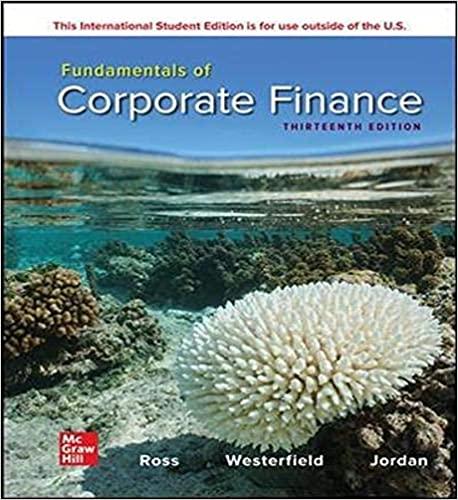Answered step by step
Verified Expert Solution
Question
1 Approved Answer
Please see attached file. Thank you. Assume that you have been asked to place a value on the fund capital (equity) of BestHealth, a not-for-profit

Please see attached file. Thank you.
| Assume that you have been asked to place a value on the fund capital (equity) of BestHealth, a | |||||
| not-for-profit HMO. Its projected profit and loss statements and retention requirements are | |||||
| shown below (in millions): | |||||
| Year 1 | Year 2 | Year 3 | Year 4 | Year 5 | |
| Net revenues | $50.0 | $52.0 | $54.0 | $57.0 | $60.0 |
| Cash expenses | $45.0 | $46.0 | $47.0 | $48.0 | $49.0 |
| Depreciation | $3.0 | $3.0 | $4.0 | $4.0 | $4.0 |
| Interest | $1.5 | $1.5 | $2.0 | $2.0 | $2.5 |
| Net profit | $0.5 | $1.5 | $1.0 | $3.0 | $4.5 |
| Estimated retentions | $1.0 | $1.0 | $1.0 | $1.0 | $1.0 |
| The cost of equity of similar for-profit HMO's is 14 percent, while BestHealth's cost of debt is 5 | |||||
| percent. Its current capital structure is 60 percent debt and 40 percent equity. The best estimate | |||||
| for BestHealth's long-term growth rate is 5 percent. Furthermore, the HMO currently has | |||||
| $30 million in debt outstanding. | |||||
| a. What is the equity value of the HMO using the free operating cash flow (FOCF) method? | |||||
| b. Suppose that it was not necessary to retain any of the operating income in the business. What | |||||
impact would this change have on the equity value according to the FOCF method? |
 UNDERSTANDING HEALTHCARE FINANCIAL MANAGEMENT Chapter 16 -- Business Combinations and Valuation PROBLEM 2 Assume that you have been asked to place a value on the fund capital (equity) of BestHealth, a not-for-profit HMO. Its projected profit and loss statements and retention requirements are shown below (in millions): Net revenues Cash expenses Depreciation Interest Net profit Estimated retentions Year 1 Year 2 Year 3 Year 4 Year 5 $50.0 $52.0 $54.0 $57.0 $60.0 $45.0 $46.0 $47.0 $48.0 $49.0 $3.0 $3.0 $4.0 $4.0 $4.0 $1.5 $1.5 $2.0 $2.0 $2.5 $0.5 $1.5 $1.0 $3.0 $4.5 $1.0 $1.0 $1.0 $1.0 $1.0 The cost of equity of similar for-profit HMO's is 14 percent, while BestHealth's cost of debt is 5 percent. Its current capital structure is 60 percent debt and 40 percent equity. The best estimate for BestHealth's long-term growth rate is 5 percent. Furthermore, the HMO currently has $30 million in debt outstanding. a. What is the equity value of the HMO using the free operating cash flow (FOCF) method? b. Suppose that it was not necessary to retain any of the operating income in the business. What impact would this change have on the equity value according to the FOCF method
UNDERSTANDING HEALTHCARE FINANCIAL MANAGEMENT Chapter 16 -- Business Combinations and Valuation PROBLEM 2 Assume that you have been asked to place a value on the fund capital (equity) of BestHealth, a not-for-profit HMO. Its projected profit and loss statements and retention requirements are shown below (in millions): Net revenues Cash expenses Depreciation Interest Net profit Estimated retentions Year 1 Year 2 Year 3 Year 4 Year 5 $50.0 $52.0 $54.0 $57.0 $60.0 $45.0 $46.0 $47.0 $48.0 $49.0 $3.0 $3.0 $4.0 $4.0 $4.0 $1.5 $1.5 $2.0 $2.0 $2.5 $0.5 $1.5 $1.0 $3.0 $4.5 $1.0 $1.0 $1.0 $1.0 $1.0 The cost of equity of similar for-profit HMO's is 14 percent, while BestHealth's cost of debt is 5 percent. Its current capital structure is 60 percent debt and 40 percent equity. The best estimate for BestHealth's long-term growth rate is 5 percent. Furthermore, the HMO currently has $30 million in debt outstanding. a. What is the equity value of the HMO using the free operating cash flow (FOCF) method? b. Suppose that it was not necessary to retain any of the operating income in the business. What impact would this change have on the equity value according to the FOCF method Step by Step Solution
There are 3 Steps involved in it
Step: 1

Get Instant Access to Expert-Tailored Solutions
See step-by-step solutions with expert insights and AI powered tools for academic success
Step: 2

Step: 3

Ace Your Homework with AI
Get the answers you need in no time with our AI-driven, step-by-step assistance
Get Started


